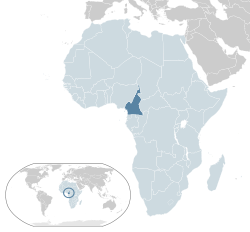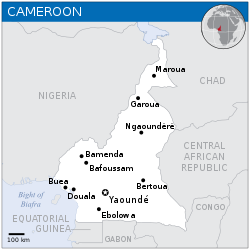Republic of Cameroon République du Cameroun | |
|---|---|
| Motto: "Paix – Travail – Patrie" (French) "Peace – Work – Fatherland" | |
| Anthem: Ô Cameroun, Berceau de nos Ancêtres (French) O Cameroon, Cradle of our Forefathers a | |
 | |
 | |
| Capital | Yaoundé[1] 3°52′N 11°31′E / 3.867°N 11.517°E |
| Largest city | Douala[1] |
| Official languages | French English |
| Ethnic groups |
|
| Demonym(s) | Cameroonian |
| Government | Dominant-party presidential republic |
| Paul Biya[1] | |
| Philémon Yang | |
| Legislature | Parliament of Cameroon |
| Senate | |
| National Assembly | |
| Independence from France | |
• Declared | 1 January 1960 |
• Annexation of former British Cameroons | 1 October 1961 |
| Area | |
• Total | 475,442 km2 (183,569 sq mi) (54th) |
• Water (%) | 0.57 |
| Population | |
• July 2013 estimate | 22,534,532[1] (56th) |
• 2005 census | 17,463,836[2] |
• Density | 39.7/km2 (102.8/sq mi) (167th) |
| GDP (PPP) | 2016 estimate |
• Total | $76.895 billion[3] |
• Per capita | $3,246[3] |
| GDP (nominal) | 2016 estimate |
• Total | $30.790 billion[3] |
• Per capita | $1,299[3] |
| Gini (2007) | medium inequality |
| HDI (2014) | low (153rd) |
| Currency | Central African CFA franc (XAF) |
| Time zone | UTC+1 (WAT) |
| Drives on | right |
| Calling code | +237 |
| ISO 3166 code | CM |
| Internet TLD | .cm |
| |
Cameroon (/ˌkæməˈruːn/; French: Cameroun), officially the Republic of Cameroon (French: République du Cameroun), is a country in Central Africa. It is bordered by Nigeria to the west; Chad to the northeast; the Central African Republic to the east; and Equatorial Guinea, Gabon, and the Republic of the Congo to the south. Cameroon's coastline lies on the Bight of Bonny, part of the Gulf of Guinea and the Atlantic Ocean.
Cameroon is home to more than 1738 different linguistic groups. French and English are the official languages. The country is often referred to as "Africa in miniature" for its geological and cultural diversity. Natural features include beaches, deserts, mountains, rainforests, and savannas. The highest point at almost 4,100 metres (13,500 ft) is Mount Cameroon in the Southwest Region of the country, and the largest cities in population-terms are Douala on the Wouri river, its economical capital and main seaport, Yaoundé, its political capital, and Garoua. After independence, the newly united nation joined the Commonwealth of Nations, although the vast majority of its territories had previously been a German colony and, after World War I, a French mandate. The country is well known for its native styles of music, particularly makossa and bikutsi, and for its successful national football team.
Early inhabitants of the territory included the Sao civilisation around Lake Chad and the Baka hunter-gatherers in the southeastern rainforest. Portuguese explorers reached the coast in the 15th century and named the area Rio dos Camarões (Shrimp River), which became Cameroon in English. Fulani soldiers founded the Adamawa Emirate in the north in the 19th century, and various ethnic groups of the west and northwest established powerful chiefdoms and fondoms. Cameroon became a German colony in 1884 known as Kamerun.
After World War I, the territory was divided between France and the United Kingdom as League of Nations mandates. The Union des Populations du Cameroun (UPC) political party advocated independence, but was outlawed by France in the 1950s. It waged war on French and UPC militant forces until 1971. In 1960, the French-administered part of Cameroon became independent as the Republic of Cameroun under President Ahmadou Ahidjo. The southern part of British Cameroons merged with it in 1961 to form the Federal Republic of Cameroon. The country was renamed the United Republic of Cameroon in 1972 and the Republic of Cameroon in 1984.
Cameroon enjoys relatively high political and social stability. This has permitted the development of agriculture, roads, railways, and large petroleum and timber industries. Nevertheless, large numbers of Cameroonians live in poverty as subsistence farmers. Power lies firmly in the hands of the authoritarian president since 1982, Paul Biya, and his Cameroon People's Democratic Movement party. The English-speaking territories of Cameroon have grown increasingly alienated from the government, and politicians from those regions have called for greater decentralization and even secession (for example: the Southern Cameroons National Council) of the former British-governed territories.
- ^ a b c d Cite error: The named reference
CIAwas invoked but never defined (see the help page). - ^ "Rapport de présentation des résultats définitifs" (PDF) (in French). Institut national de la statistique. p. 6. Retrieved 21 July 2012.
- ^ a b c d "Cameroon". International Monetary Fund.
- ^ "Distribution of family income – Gini index". The World Factbook. CIA. Retrieved 1 September 2009.
- ^ "2015 Human Development Report" (PDF). United Nations Development Programme. 2014. Retrieved 14 December 2015.

